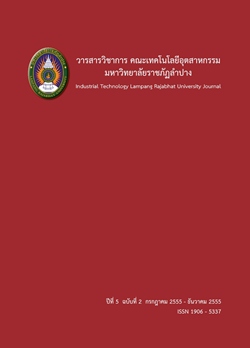การพัฒนางานหัตถกรรมเครื่องปั้นดินเผา ในเอกลักษณ์ของชุมชนมอญปากเกร็ด สําหรับเป็นผลิตภัณฑ์ร่วมสมัย
Keywords:
เครื่องปั้นดินเผา, ชุมชนมอญ, ผลิตภัณฑ์ร่วมสมัย, pottery, ethnic mon community, contemporary productsAbstract
การวิจัยครั้งนี้มี วัตถุประสงค์ในการวิจัย คือ 1) เพื่อศึกษาวิถีชีวิตของชุมชนมอญปากเกร็ด ที่เกี่ยวเนื่องกับเครื่องปั้นดินเผาในด้านรูปแบบผลิตภัณฑ์ กระบวนการผลิตและการตลาด 2) เพื่อศึกษา และวิเคราะห์สภาพปัญหาเครื่องปั้นดินเผาของชุมชนมอญปากเกร็ดในปัจจุบัน 3) เพื่อการออกแบบและ พัฒนารูปแบบผลิตภัณฑ์ กรรมวิธีการผลิตเครื่องปั้นดินเผาของชุมชนมอญปากเกร็ด ที่สอดคล้องกับ อัตลักษณ์ท้องถิ่นและตรงตามความต้องการของตลาด ประชากรและกลุ่มตัวอย่างที่ใช้ในการวิจัยครั้งนี้ จำแนกออกเป็น 2 กลุ่ม คือ 1) กลุ่มสำหรับศึกษาข้อมูล คือ ผู้ผลิตผลิตภัณฑ์หัตถกรรมเครื่องปั้นดินเผา 2) กลุ่มสำหรับการวิเคราะห์ข้อมูลประกอบการออกแบบผลิตภัณฑ์ร่วมสมัย ได้แก่ ผู้ผลิต ผู้จำหน่าย และผู้บริโภค
ผลการวิจัยสรุปได้ 3 ส่วน ดังนี้ 1) พบว่า ชุมชนมอญเกาะเกร็ดส่วนใหญ่ประกอบอาชีพ ทำเครื่องปั้นดินเผากันอย่างแพร่หลาย เนื่องจากชาวมอญมีฝีมือในการทำเครื่องปั้นดินเผามาแต่โบราณ มีชื่อเสียงเป็นที่รู้จักและยอมรับกันทั่วไปมาแต่อดีต สำหรับประเภทของผลิตภัณฑ์เครื่องปั้นดินเผา ที่นิยมผลิตในปัจจุบันมี 2 ประเภท คือ ประเภทสิ่งของ เครื่องใช้ และประเภทสวยงาม ที่นิยมอยู่เดิม 2) พบว่า สีของผลิตภัณฑ์เครื่องปั้นดินเผาที่นิยมใช้อยู่เดิมมี 2 โทนสี คือ สีดินแดง และสีดินดำการทดลอง พบว่า สีสำหรับเขียนลวดลายโดยใช้วิธีการเขียนสีในเคลือบเพื่อเพิ่มสีและลวดลาย ให้ผลิตภัณฑ์จากการ ทดลองใช้ส่วนผสมของน้ำเคลือบและสีสำเร็จรูปในอัตราส่วนต่าง ๆ กัน มีผลทำ ให้ผลิตภัณฑ์มีความ สวยงามมากขึ้นและมีมูลค่าเพิ่มสูงขึ้น 3) พบว่า ผลิตภัณฑ์ที่อยู่ในความต้องการของตลาด คือ ประเภท งานวิจิตร จากผลการศึกษาดังกล่าวพอสรุปได้ว่า แนวทางการประยุกต์ใช้งานหัตถกรรมเครื่องปั้นดินเผา ในเอกลักษณ์ของชุมชนมอญปากเกร็ด ต้องคำนึงถึงแนวคิดการออกแบบ และพัฒนา 5 ประการ คือ 1) ลักษณะเฉพาะถิ่น 2) ความสวยงาม 3) ประโยชน์ใช้สอย 4) ขนาดสัดส่วน 5) กรรมวิธีการผลิต จากการ ทดลองผลิตพบว่า เป็นแนวทางที่สามารถสร้างมูลค่าเพิ่มให้ผลิตภัณฑ์ได้และมีความสอดคล้องกับ ความต้องการของตลาด
The Development of contemporary products from The Pak Kret ethnic Mon-Style pottery
The study was conducted with the following aims: 1) to examine the lifestyle of Pak Kret’s Mon-ethnic groups regarding their pottery business through product design, production and marketing 2) to study problems and solutions concerning the pottery products; 3) to design and develop products suitable for the Mon cultural identity and responsive to future market needs. The subjects were divided into 2 groups: 1) informant potters in the target community and 2) manufacturers, distributors, and consumers who provided data which were analyzed for the purpose of product design.
The results are summarized as follows. First, in terms of lifestyle, product type, production, and marketing, it was found that the majority of Mon community residents were in the pottery-making business because Mon people are skillful potters with long-known reputation and popularity. They produce two types of popular contemporary pottery products: household utensils and decorative items. Second, in terms of product design and development, it was found that popular color schemes are earthy red and earthy black. The researcher experimented with colors and found that painting with the in-glaze method adds colors and patterns to the products. Experimentation with glazing mixtures of different ratios between a glaze and paint increased the aesthetic characteristics and value of the products. Third, regarding design and development of products based on the Pak Kret’s Mon ethnic identity, it was found that fine art items are marketable. Based on this study, it was concluded that the application of the Pak Kret’s Mon ethnic identity in pottery needs to take five concepts into consideration: 1) local characteristics, 2) aesthetics, 3) utility, 4) size and proportion, and 5) manufacturing procedure. Based on these five concepts, the study developed a manufacturing procedure, evaluated the design and development, and found that the approach added value to the products.






